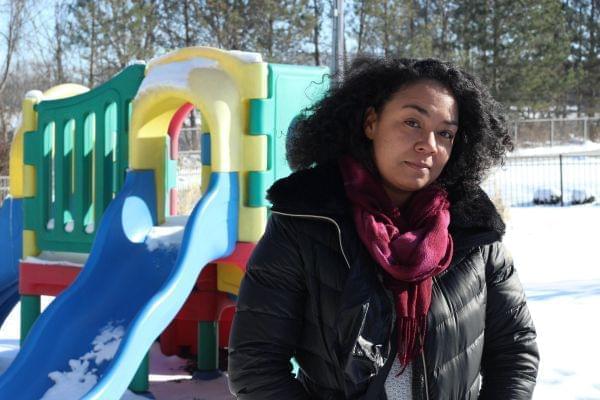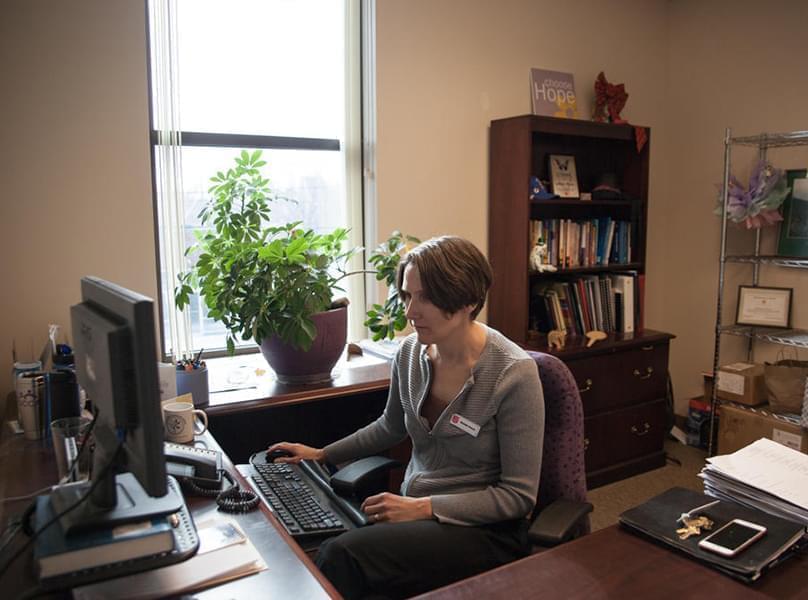For Sex Workers Struggling With Addiction, A Safe Path To Recovery Can Be Hard To Find

Julia Gilliam is a coordinator at the women's residential treatment program at Mary Haven. She works with mother's and pregnant women who are recovering from addiction. She says nearly half have experienced sex trafficking. Esther Honig/Side Effects Public Media
In leggings and a long black hoodie, Ray walked idly up and down Sullivant Avenue in Columbus, Ohio. A block away, an elementary school had let out for the day and students walked home. For Ray, work had just started.
“You just walk around until you catch a date,” she said.
Ray is her nickname. She asked she not be identified because she sells sex in order to purchase heroin. At 28, she’s rail thin and has long black hair.
Ray said she’s usually able to get work from a group of her regular clients. When that doesn’t work, she comes out here, where getting in the car with strange men leaves her vulnerable to assault. She said she’s been raped twice. As she talked, her eyelids slowly fell over her pale blue eyes.
“I want to quit and go home real bad, but it's just really hard,” she said. “You feel like you're trapped here.”
For some women addicted to opioids, selling sex to buy drugs can become a dangerous way of life. Ray may work for herself now, but like other women interviewed for this story, she could eventually find herself exploited by a pimp or a drug dealer.
In Columbus, law enforcement and anti-human trafficking advocates are seeing an increase in the number of women who are trafficked due to an opioid addiction, meaning they are forced or coerced to engage in sex work.
When these individuals want to seek help, treatment options are not always available quickly enough to provide them a safe path to recovery. And they often need safe housing before they can leave this life behind.
For women seeking help, they can call the National Human Trafficking Hotline. That call will bring them to the Salvation Army of central Ohio, which has run an anti-human trafficking program for the last ten years. Director Michelle Hannan says opioid addiction now affects nearly all of their cases.
“We’ve seen a really dramatic increase in how frequently heroin intersects with our cases and the degree to which the drug is being used a as control technique," she said.
When caseworkers come across a survivor with opioid dependency, often their first priority is to get them into detox — this helps them through the painful drug withdrawals. Hannan said thanks to Ohio’s Medicaid expansion and their partnership with a local treatment facility, Mary Haven, they’re often able to get them in immediately. However, there are instances when space fills up and people are turned away.

Michele Hannan is the director of the Salvation Army's anti-human trafficking department. Over the last ten years, she seen opioid addiction affect an increasing number of cases.
“That’s the toughest part,” said Hannan. “If someone says at this particular moment, ‘I’m ready’ and we can’t act in that moment, that’s when we’re going to lose that person until the next time that they’re ready.”
Considering the high rates of overdoses, and other dangers associated with sex trafficking, Hannan said there may not always be a next time. Women in these situations are often victims of violent assault by their pimps, dealers or clients. They also risk diseases such as HIV and potentially fatal infections from dirty syringes.
If a patient makes it through detox and doesn’t relapse — as many do — the next step for the Salvation Army case workers is to help them find long-term addiction treatment. Outpatient care is also an option, but because survivors of human trafficking experience trauma and homelessness, many do best in long-term residential treatment.
These programs last several months to a year and require intense supervision and care from mental health professionals. Julia Gilliam, a coordinator at Mary Haven’s residential program for women, said it can take six to eight weeks to get in. But she insisted, they never just tell patients to wait.
“That’s not how that works,” she said.“There’s always something that needs to be done.”
Many women who have been trafficked have lost their ID and any vital documentation necessary to apply for Medicaid or health insurance. While women work on gathering identification, they have access outpatient care, such as medications and counseling.
Every so often, a patient will relapse before making it off the waitlist. Gilliam said she wishes that they had more resources.
“But with the staff that we have available and the beds and the space that we have available, it works right now,” she said.
For women who are homeless or who live under the control of a trafficker and have nowhere safe to live (as is the situation for many of the women interviewed for this story), six to eight weeks can feel like an eternity. Gilliam says a lack of safe housing could keep many women trapped.
“You know that you can run, but there’s nowhere to run to,” said Gilliam. “If there’s no safe housing for them when they leave, then they can be found very easily.”
Back on Sullivant Avenue, Ray said she recently spent five days in jail where she couldn’t use drugs.
“When you're sober all you do is think,” said Ray. “So it's just not worth it really.”
Ray has been thinking of going into treatment. When she is ready, perhaps the resources she needs will be there for her.
This story was produced by Side Effects Public Media, a news collaborative covering public health.
Links
- How Heroin Traps Women In A Cycle of Sex Work And Addiction
- An Indiana Law Makes Harm Reduction For Opioid Addiction Into A Yearly Battle
- Doctors Say Telemedicine Can’t Replace In Person Addiction Care
- Task Force Searches For Solutions To Opioid Addiction
- New Moms Need Daily Addiction Help To Stay In Recovery ... And Stay With Their Kids
- Afraid To Treat Pregnant Women, Doctors Drop Addicted Patients At A Vulnerable Time
- Moms-To-Be With Addiction Face Obstacles At Every Turn
- To Fight Drug Addiction, Hospitals Hire Recovering Addicts
